|
MAIN PAGE
> Back to contents
Historical informatics
Reference:
Kattsina T.A., Shestakov V.N., Pomazan V.A.
Descriptive statistics and visualization of historical data on charitable institutions in Eastern Siberia in the 19th century.
// Historical informatics.
2023. ¹ 4.
P. 10-29.
DOI: 10.7256/2585-7797.2023.4.68781 EDN: TNFXTT URL: https://en.nbpublish.com/library_read_article.php?id=68781
Descriptive statistics and visualization of historical data on charitable institutions in Eastern Siberia in the 19th century.
Kattsina Tatyana Anatolievna
ORCID: 0000-0001-6566-9678
Doctor of History
Professor, Department of Theory and Methodology of Social Work, Siberian Federal University
660041, Russia, Krasnoyarsk Territory, Krasnoyarsk, Svobodny Ave., 79

|
tkatsina@sfu-kras.ru
|
|
 |
Shestakov Viacheslav Nikolaevich
ORCID: 0000-0001-7737-2900
PhD in Philosophy
Associate Professor, Department of Modern Educational Technologies, Siberian Federal University
660041, Russia, Krasnoyarsk Territory, Krasnoyarsk, Svobodny Ave., 79

|
shestakoffs@yahoo.com
|
|
 |
|
Pomazan Valery Aleksandrovich
ORCID: 0000-0003-4690-0795
Senior Lecturer, Department of Modern Educational Technologies, Siberian Federal University
79 Svobodny Ave., Krasnoyarsk, 660041, Russia

|
vpomazan@sfu-kras.ru
|
|
 |
|
DOI: 10.7256/2585-7797.2023.4.68781
EDN: TNFXTT
Received:
22-10-2023
Published:
29-11-2023
Abstract:
The article presents the potential of information technologies and descriptive statistics in solving research problems aimed at revealing the possibility of assessing the effectiveness of accumulated historical experience in such an important area as social work. The purpose of the work is to create tools for a descriptive analysis of historical data on charity institutions in Eastern Siberia XIX century. The methods of research are: data previously collected from diverse archival sources; descriptive statistics in the form of contingency tables and diagrams. The article presents visualized generalized data that allows one to evaluate and interpret the volume, structure and dynamics of charitable assistance in XIX century Eastern Siberia. The subject of the research is institutions of public charity in Eastern Siberia in the 19th century. The novelty and value of the research lies in the original structure of the database, the purpose of which is to systematize and summarize the main characteristics (organizational, financial, socio-demographic) of charitable institutions in their dynamic development and based on a wide range of written sources: office documentation; reference and statistical materials; annals. The specifics of the source base and the goals of the study determined the use of an interdisciplinary approach, which was built primarily on the basis of a synthesis of historical, sociological and information knowledge. Using methods, descriptive statistics and visualization of historical data, the capabilities of the database for systematization, analysis, synthesis and grouping of information are characterized. The study contributes to the elimination of territorial and problematic imbalances in the study of the network of charitable institutions in the Russian Empire, ensures effective systematization of primary information into a database, which is an information product of multi-purpose use, the structure of which is not related to the structure of source documents, and its value as an integral source lies in the subordination content of a specific research problem.
Keywords:
social assistance, public charity, charity, Eastern Siberia, charitable institutions, database, information technology, statistics, descriptive statistics, dashboard
This article is automatically translated.
You can find original text of the article here.
Introduction The study of the history of social assistance is marked by the formulation of a number of problems, including its regional development, and requires the expansion of the research source base, which largely determines the success of generalization and conclusions of the entire work. When studying the specifics of the formation and development of the public charity system in the provinces (Yenisei, Irkutsk) and regions (Transbaikal, Yakutsk) of Eastern Siberia, we systematized information on public charity and charitable institutions (craft houses, orphanages, night shelters, almshouses, etc.) into a database. The electronic database [1] was designed and filled on the basis of a wide range of historical sources (their list included 42 names). The publication of a statistical nature "Charity in Russia" served as the main source with a high number of values of the categories of analysis under consideration [2]. Taking into account the availability of information about the object under study, "Commemorative books ..." of individual provinces and regions (in Eastern Siberia, their printing began in 1861 with the Irkutsk province), "Reviews ..." (in the editions of 1879-1897 – the subtitle "Appendix to the most comprehensive report") and "Statistical reviews ..." of provinces (regions), published by local statistical committees from 1870 to 1916 in the form of a separate part to the annual report of the governor. Significant information about charitable institutions (workhouses and craft houses) is gleaned from the works of the actual state councilor Yu.A. Gagemeister [3] and the first Yenisei governor A.P. Stepanov [4]. Reports and charters of charitable institutions, both published and extracted from the funds of the central (State Historical Archive) and regional archives of the Krasnoyarsk Territory, Irkutsk and Chita regions, the Republic of Sakha (Yakutia), were used in connection with the data of the main source. Chronicles [5, 6, etc.] are used as additional sources. The comparison of sources to determine the reliability of information relating to the same issue made it possible to avoid mistakes, for example, when determining the date of the actual opening of a charitable institution. Working with data diverse in composition and content, but not rigidly structured in form, we did not take all the material, but only the necessary one, that is, we introduced free text of sources of different types. Because of this, the database is already a new, aggregated source, the structure of which is not related to the structure of the source documents, and its value as an integral source lies in subordinating the content to a specific research task. It should be noted that in recent years, the technology of databases and storage systems of historical documents is often used for research in the field of socio-economic history [7-11, etc.], and information technologies are increasingly being used in the creation of professional scientific and educational resources, in analytical work with the integrated use of not only statistical, but also textual, cartographic, visual, multimedia information, in the development of analytical tools for processing and analyzing historical documents, searching for relevant information [12-20]. Materials and methods Let's consider the possibilities of using information technologies and descriptive statistics in solving a number of research tasks aimed at studying the history of social assistance in Eastern Siberia of the XIX century. The data used is structured into a simple spreadsheet of the universal Microsoft Excel program with the number of rows (studied objects) – 94, the number of columns – 8 (object name, opening date, subordination, real estate and capital, capacity, contingent, specifics of services, source code). PostgreSQL, a free object–relational database management system, allows you to maintain the database in working order, archive information and create backups, modify it in accordance with newly arisen needs or changed conditions. Its integration with the popular PHP scripting language (Hypertext Preprocessor) made it possible to integrate the database into a network resource. The requested information is generated from the table automatically and displayed on the monitor screen. The "Administrator" mode allows you to add, change, delete and extract data. Data processing (grouping, descriptive statistics) is implemented in the Microsoft Excel 2013 spreadsheet processor. Pivot tables and pivot charts are used as processing tools. Pivot tables are meta-tables relative to the source data table. They allow you to group homogeneous features of the studied objects, perform basic mathematical operations with quantitative features. For example, charitable institutions are grouped by type, the occurrence of each type is calculated. Pivot charts are a logical continuation of pivot tables, visualization of the results of grouping and calculations. By constructing, for example, a diagram of the number of institutions by type, you can get individual slices by province or see the overall picture for all provinces. Additionally, a software package for statistical analysis Statistica 10.0 was used to check the distribution of data, calculate basic descriptive statistics (medians, quartiles, span). Visual representation (graphs, diagrams, tables) of the most important information grouped by meaning is implemented in the form of a dashboard. Descriptive statistics and data visualization The authors structured the source database by highlighting the following data about each object: belonging to a province, district or city, the year of creation of a charitable institution, subordination, availability of own real estate and capital, capacity, description of the contingent, specifics of services, the cipher of the source. In order to highlight more useful and suitable information for quantitative analysis, the database described above has been further analyzed. For grouping and counting, additional parameters of charitable institutions are allocated from the already available data. They were added as the text content of the main parameters was studied. A consistent study of the records of charitable institutions allowed us to detect patterns in the description of their capital and real estate, the contingent, and the specifics of services.
The list of additional parameters: province; district; locality; type of settlement (city, village); the period to which the year of creation belongs (centuries are divided into quarters); type of institution (almshouse, lodging house, shelter, workhouse, canteen); general subordination; specified subordination; cost of real estate; capital; income; donations from individuals and organizations; donations from government and urban, rural institutions; annual maintenance; income from paid services; capacity – the number of seats; capacity – how many were kept. As well as binary parameters characterized by the presence or absence of a feature: contingent – children; contingent – adults; contingent – female; contingent – male; contingent – orphans; contingent – elderly; contingent – sick; contingent – crippled; contingent – mentally ill; contingent – homeless; contingent – unable to work; contingent – poor; contingent – Orthodox; contingent – clergy; contingent – burghers; contingent – peasants; contingent – locals; contingent – migrants; contingent – exiles; specifics of services – free of charge; specifics of services – paid; specifics of services – earn by yourself; maintenance by alms; services – accommodation; services – food; services – money; services – training; services – care. Such a significant number of binary features is due to the fact that many of them are not mutually exclusive. For example, the contingent of a separate almshouse can be both female and male, poor, Orthodox, local and non-local residents. Note that with the current volume of the database, not all signs have found a significant frequency of occurrence, which would allow us to draw generalizing conclusions. However, it is too early to consider them useless, additional sources can give low-frequency signs a new relevance. Below is a frequency table of public charity and charitable institutions grouped by provinces and districts of Eastern Siberia (Table 1). Table 1. Institutions of public charity and charitable nature grouped by provinces and districts of Eastern Siberia | Territorial division | Number of institutions | | Yakut region | 6 | | Yakutsk | 6 | | Irkutsk province | 36 | | Nizhneudinsky district | 2 | | Irkutsk District | 2 |
| city of Kirensk | 1 | | Irkutsk | 21 | | the city of Verkholensk | 1 | | Verkholensky district | 4 | | Balagan district | 5 | | Trans - Baikal region | 15 | | Troitskosavsky district | 1 | | Nerchinsk-Zavodsky district | 1 | | Nerchinsky district | 1 |
| G. Chita | 4 | | Troitskosavsk | 5 | | city of Nerchinsk | 1 | | Verkhneudinsk | 2 | | Yenisei Province | 37 | | Minusinsky district | 6 | | Kansky district | 1 | | Yenisei District | 2 | | Minusinsk | 3 |
| Krasnoyarsk | 14 | | The city of Yeniseisk | 4 | | Achinsk city | 2 | | Achinsk district | 5 | According to the summary table, charitable institutions are represented by 94 records, which are grouped by provinces and regions: Yakut, Irkutsk, Trans-Baikal and Yenisei. Charitable institutions of Irkutsk and Yenisei provinces form the basis of the database – 36 and 37 records, respectively. The administrative centers of these provinces contain the maximum values of the number of charitable institutions: Irkutsk – 21, Krasnoyarsk – 14. In the Trans–Baikal province, the separation of the number of charitable institutions of the administrative center from the district centers is not so pronounced: Chita is 4, given that the median for districts and cities is 2 charitable institutions, and the interquartile range (Qn –Qb) is from 1 to 5. It is noteworthy that all the institutions of the Yakut region are concentrated in its administrative center. The dates of creation of charitable institutions fit in the period from 1799 to 1902 . The division of the XIX century into quarters made it possible through grouping to establish the most fruitful periods for charity with division by provinces. The summary diagrams in Figs. 1 and 2 well illustrate the dynamics of the emergence of charitable institutions. 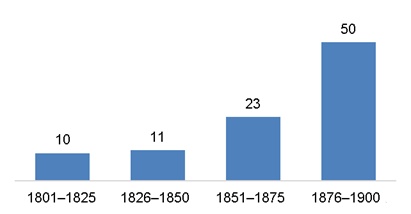
Fig. 1. The total number of new charitable institutions with distribution by quarters of the XIX century. 
Fig. 2. The number of new charitable institutions with distribution by quarters of the XIX century in the context of provinces and regions of Eastern Siberia The diagram in Fig. 2 shows a general increase in the number of charitable institutions from the first to the last quarter of the XIX century. The change is uneven. There is an increase in the number of charitable institutions in the second half of the XIX century (see Fig. 1). Figure 3 shows the ratio of rural and urban care institutions for each administrative-territorial unit. 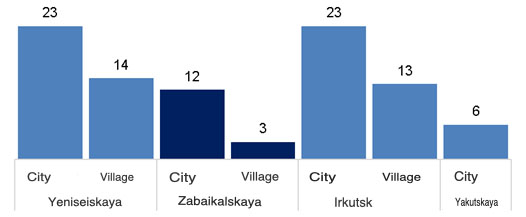
Fig. 3. The number of charitable institutions with distribution by type of settlement in the context of provinces and regions of Eastern Siberia In each of the provinces and regions, the ratio is in favor of the city, where there are more charitable institutions. As a percentage, the scale of the difference between the number of charitable institutions in the city and in the countryside in the provinces is 61%, taking into account 100% of the difference in the Yakut and 39% in the Yenisei. Figures 4 and 5 show the structure of public charity and charitable institutions based on the type: canteen, workhouse, orphanage, night shelter, almshouse. 
Fig. 4. The total number of institutions of public charity and charitable nature with distribution by type
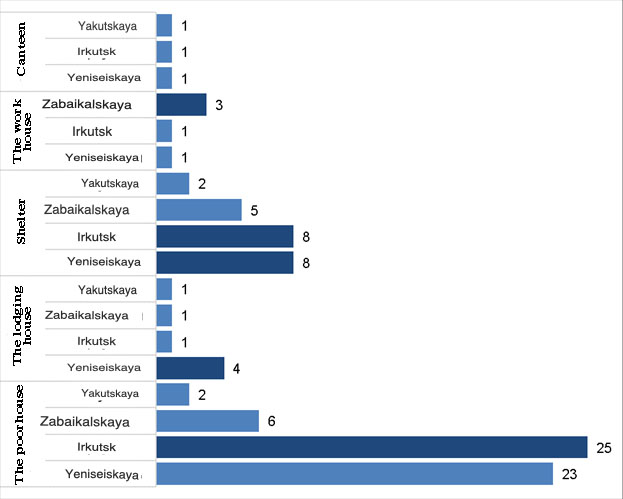 Fig. 5. The number of charitable institutions with distribution by type in the context of provinces and regions of Eastern Siberia Collectively, almshouses dominate in all provinces in terms of the number of new arrivals, with shelters in second place. In the Yenisei and Irkutsk provinces, this number is overwhelming, in the Trans-Baikal and Yakut provinces, everything is not so clear. There are not so many institutions in Yakutsk (6) and they are evenly distributed by type, in Zabaikalsky there are more (15), but the number of shelters is close to the number of almshouses. It is noteworthy that in the Trans–Baikal province there are the most workhouses (3), and in the Yenisei province there are flophouses (4). Figure 6 shows the structure of the general departmental affiliation of charitable institutions. 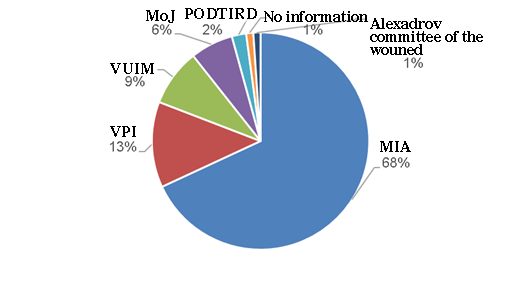
Fig. 6. Structure of departmental affiliation of charitable institutions The majority of institutions (68%) are subordinated to the Ministry of Internal Affairs (MIA), the Department of Orthodox Confession (VPI) – 12%, the Department of Institutions of Empress Maria (VUIM) – 8%, the Ministry of Justice (MoJ) – 6%, the Guardianship of the Houses of Diligence and Workhouses (PODTiRD) – only 2%. The remaining options are private and not systemic in nature. Let us turn to the data on the number of people held in charitable and charitable institutions, divided by provinces, quarters of the XIX century. in the context of types of institutions (Table 2). Table 2. The number of persons held in institutions of public charity and charitable nature | Province / period | Poorhouse | Night shelter house | Shelter | Workhouse | The overall result | | Yenisei Province | 296 | 24 | 128 | – | 448 | | 1801-1825 |
40 | – | | – | 40 | | 1826-1850 | 53 | – | 39 | – | 92 | | 1851-1875 | 152 | 7 | | – | 159 | | 1876-1900 |
51 | 17 | 89 | – | 157 | | Trans - Baikal region | 100 | – | 199 | – | 299 | | 1801-1825 | – | – | – | – | – | | 1826-1850 |
69 | – | – | – | 69 | | 1851-1875 | – | – | 45 | – | 45 | | 1876-1900 | 31 | – | 154 | – | 185 | | Irkutsk province |
344 | 53 | 176 | 100 | 673 | | 1801-1825 | 34 | – | | 100 | 134 | | 1826-1850 | 15 | – | 60 | – | 75 | | 1851-1875 |
215 | – | | – | 215 | | 1876-1900 | 80 | 53 | 116 | – | 249 | | Yakut region | 31 | | 20 | – | 51 | | 1801-1825 |
– | – | – | – | – | | 1826-1850 | – | – | – | – | – | | 1851-1875 | – | – | – | – | – | | 1876-1900 |
31 | | 20 | – | 51 | | The overall result | 771 | 77 | 523 | 100 | 1 471 | According to table 2, in the provinces and regions of Eastern Siberia, the total number of people held in charitable institutions was 1,471. Most of all in almshouses and orphanages, much less in workhouses and night shelters. It makes sense to consider the quantitative values presented in the table as indicative and incomplete. Their value lies in the ability to characterize the structure and dynamics of the volume of charitable assistance at least at the level of trends. Judging by the last column (total), from the first to the last quarter of the XIX century. there is a tendency to increase the number of people receiving places in charitable institutions. It should be borne in mind that these are newly appearing places, so it is more correct to count the number of places as a cumulative total (Table 3). Table 3. The number of persons held in charitable and charitable institutions on an accrual basis | Province period | Almshouse | Flophouse | Shelter | Workhouse |
The overall result | | Yenisei Province | | 1801-1825 | 40 | 0 | 0 | 0 | 40 | | 1826-1850 | 93 | 0 | 39 | 0 | 132 | | 1851-1875 | 245 | 7 | 39 |
0 | 291 | | 1876-1900 | 296 | 24 | 128 | 0 | 448 | | Trans - Baikal region | | 1801-1825 | – | – | – | – | – | | 1826-1850 | 69 | 0 |
0 | 0 | 69 | | 1851-1875 | 69 | 0 | 45 | 0 | 114 | | 1876-1900 | 100 | 0 | 199 | 0 | 299 | | Irkutsk province | | 1801-1825 | 34 |
0 | 0 | 100 | 134 | | 1826-1850 | 49 | 0 | 60 | 100 | 209 | | 1851-1875 | 264 | 0 | 60 | 100 | 424 | | 1876-1900 | 344 |
53 | 176 | 100 | 673 | | Yakut region | | 1801-1825 | – | – | – | – | – | | 1826-1850 | – | – | – | – | – | | 1851-1875 |
– | – | – | – | – | | 1876-1900 | 31 | 0 | 20 | 0 | 51 | With this calculation, the volume of aid in each new quarter of the XIX century is shifted in a big way, and this is true. Irkutsk (673) and Yenisei (448) provinces are still in the leaders of aid. The following table shows the structure of the contingent to which charitable assistance was provided. Numerical values for provinces indicate the number of mentions of a certain feature of the contingent. In total, 18 signs were identified: children, adults and homeless, sick, etc. Table 4. Structure of the characteristics of the contingent of charitable institutions | Sign | Yeniseiskaya province | Zabaikalskaya area | Irkutsk province | Yakutskaya area |
The overall result | | Children | 9 | 8 | 12 | 4 | 33 | | Female gender | 14 | 12 | 16 | 3 | 45 | | Male gender | 17 | 11 | 16 | 3 |
47 | | Adults | 29 | 10 | 27 | 4 | 70 | | Elderly | 17 | 8 | 19 | 2 | 46 | | Patients | 6 | | 2 | |
8 | | Crippled, blind, deaf | 9 | 3 | 9 | 1 | 22 | | Mentally ill | 2 | | 3 | | 5 | | Homeless | 3 | | 2 | | 5 |
| Not able to work | 3 | 1 | 4 | 2 | 10 | | The poor | 8 | 5 | 5 | 1 | 19 | | Orthodox | 8 | 2 | 3 | | 13 |
| Clergy | | | 4 | | 4 | | Philistines | 4 | 1 | 1 | 1 | 7 | | Peasants | 7 | | 6 | | 13 | | Local residents |
8 | 7 | 12 | 2 | 29 | | Migrants | 2 | | 2 | | 4 | | Exiles | 6 | 3 | 6 | 1 | 16 | For each province and region in the table, the signs that have gained more mentions in the descriptions of charitable institutions are highlighted in color. This approach suggests priority areas of assistance. In all four provinces, these are: adults, equally men and women, a little less elderly, less often children, local residents, less often crippled, blind and deaf. Some territories have their own priorities: in the Yenisei province – the poor, the Orthodox; in the Trans–Baikal region - the poor, in the Yakut region – the unable to work.
Table 5 shows the specifics of the services provided in charitable institutions: the form of services (paid, free or based on the provision of earnings), what the service contains (alms, accommodation, food, money, training, care). Table 5. Specifics of services | Specifics of services | Yeniseiskaya province | Zabaikalskaya area | Irkutsk province | Yakutskaya area | The overall result | | Is free | 34 | 13 | 33 | 5 | 85 | | Paid | 6 | 7 | 7 | 2 |
22 | | Earn by yourself | 1 | 3 | 1 | | 5 | | Maintenance by alms | 6 | | 4 | | 10 | | Placement | 34 | 14 | 34 | 5 |
87 | | Food | 20 | 11 | 20 | 4 | 55 | | Money | 1 | | 6 | 1 | 8 | | Training | 6 | 6 | 6 | 2 |
20 | | Care | 2 | 2 | 3 | | 7 | In terms of the specifics of services, the provinces and regions of Eastern Siberia are quite synchronous. Priority options: free, much less paid. Most often, accommodation, food and less often training are provided. Table 6 shows the signs of the revenue side of charitable institutions: who donated (individuals and organizations or government agencies); whether there is an annual maintenance and income from paid services. Table 6. Income structure | Sign | Yeniseiskaya province | Zabaikalskaya area | Irkutsk province | Yakutskaya area | The overall result | | Donations from individuals and organizations | 24 | 6 |
10 | 2 | 42 | | Annual maintenance | 6 | 1 | 2 | 1 | 10 | | Income from paid services | 5 | 2 | 5 | 1 | 13 | Table 6 shows that private individuals and organizations are more often mentioned as donors than government agencies (42/26). But this advantage is created by the Yenisei province, in the other three administrative-territorial divisions of Eastern Siberia, the ratio seems to be parity. It should be noted that paid services make up an important part of the income of charitable institutions. For clarity, the ability to systematically look at the database in a network resource and analyze it by setting up filters, a dashboard has been developed in Excel (Fig. 7-10). 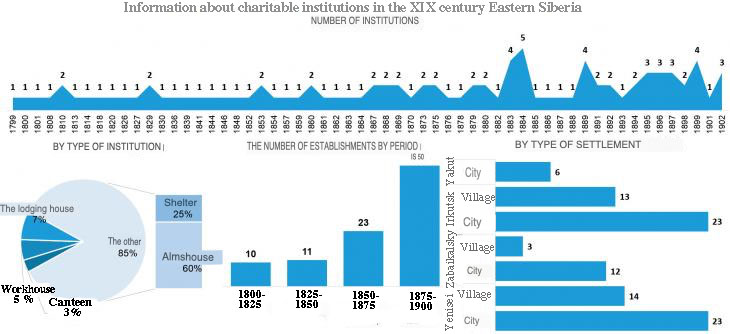
Fig. 7. Dashboard fragment, screen 1 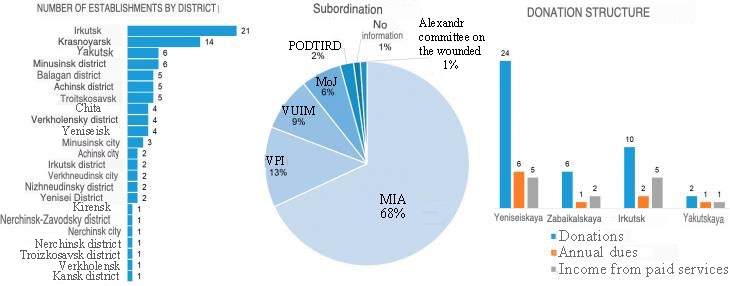
Fig. 8. Dashboard fragment, screen 2
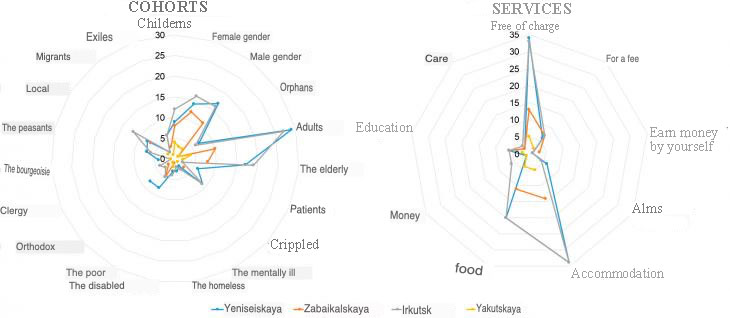 Fig. 9. Dashboard fragment, screen 3  Fig. 10. Dashboard fragment, data filtering buttons A dashboard (a visual representation of the most important information grouped by meaning on one screen) consists of a set of diagrams and control buttons (slices) that control data filtering. Diagrams are available: the number of establishments by year (linear), the number of establishments by type (circular with a callout), the number of establishments by period (histogram), by type of settlement (linear), by district (linear), by subordination (circular), by donation structure (histogram), by mentioning the characteristics of the contingent (petal), according to the specifics of services (petal). The following slices have been created for data filtering and dynamic data restructuring: the period of creation (by quarters of a century), the years of creation, the province, the district, the type of settlement and the general subordination. Figure 11 shows the first dashboard screen with a set of filters: Yenisei province, rural type of settlement, general subordination of the Ministry of Internal Affairs. 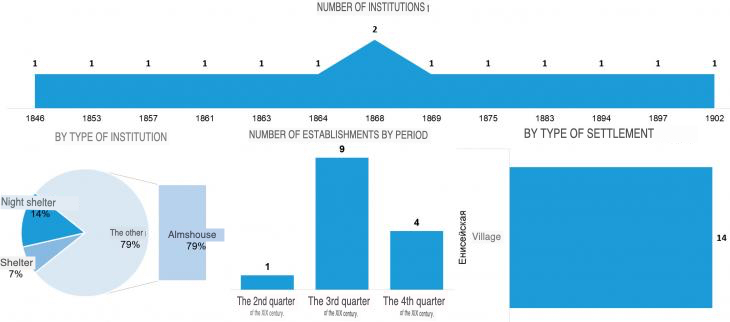 Fig. 11. Dashboard with a set of filters, screen 1 With such settings, 14 objects (types of charitable institutions) were found in the database. All charts have changed their appearance according to the selected filters. Conclusion The database is intended for research in the field of social history, it is a set of indicators on the number, contingent, material base, specifics of services of public charity and charitable institutions. It contributes to the elimination of territorial and problematic imbalances in the study of the network of institutions of public charity and charitable nature in the Russian Empire, provides effective systematization of primary information, is an information product of multipurpose use. Visual representation of data by means of a dashboard makes it easier to perceive and analyze the information of a database created in a spreadsheet format, quickly assess the state and dynamics of the system of social assistance institutions in the provinces and regions of Eastern Siberia of the XIX century by several time slices. The use of a number of techniques of the method of descriptive statistics in the processing of materials collected in the database showed: - most of all in the considered territories of charitable institutions in Irkutsk and Krasnoyarsk; - from the first to the last quarter of the XIX century, a general increase in the number of charitable institutions is noticeable, the growth of which accelerates by the end of the century; - in each province , the ratio of the number of charitable institutions in the city and in the countryside in favor of the city; - in total, almshouses dominate in all provinces in terms of the number of those who have appeared, orphanages are in second place; - most places are in almshouses and orphanages, much less in workhouses and night shelters; - the prevailing structure of the contingent: adults, equally men and women, slightly less elderly, less children, local residents, less often crippled, blind and deaf; - priority options for the specifics of services: free of charge, accommodation, food and less often training.
References
1. Certificate of state registration of the database No. 2017621434 Russian Federation. Register of charitable institutions in Eastern Siberia (1822–1870): No. 2017620907: application. 08/14/2017: publ. 12/07/2017. T. A. Kattsina; applicant Federal State Autonomous Educational Institution of Higher Education “Siberian Federal University”.
2. Charity in Russia. (1907). Compiled by the Highest order of His Imperial Majesty's Own Office of the Institutions of the Empress Maria. T. II. List of charitable institutions. Part II. Provinces and regions: Olonets – Yaroslavl, Privislinsky, Caucasus, Central Asia and Siberia. II. Additional list of charities. St-Peterburg.
3. Statistical review of Siberia, compiled by the highest order of His Imperial Majesty, under the Siberian Committee, by the actual state councilor. (1854). [Yu.A.] Gagemeister: in 3 hours. Part 2. St-Peterburg: Printing house II Dept. Own E.I.V. office.
4. Stepanov, A. P. (1835) Yenisei province: in 2 hours. Part 2. St-Peterburg: printing house of Konrad Wingeber.
5. Irkutsk Chronicle (chronicles of P. I. Pezhemsky and V. A. Krotov) with a preface, addition and notes by I. I. Serebrennikova. (1911). Irkutsk: Steam printing house I. P. Kazantseva.
6. Kytmanov, A. I. (2016) Brief chronicle of the Yenisei district and Turukhansk region of the Yenisei province. 1594–1893. Krasnoyarsk: Siberian Federal University.
7. Razinkov, S. L., Zakharovsky, L.V. (2020) Information potential of the database “Vocational and technical education in the Sverdlovsk region (1920–1950s)”. Historical computer science, 3, 51-70. Retrieved from https://e-notabene.ru/istinf/article_33935.html
8. Kattsina, T. A., Pomazan, V. A. (2013). Experience in developing a database “Organizations of assistance to victims of wars of the early 20th century”. Prospects for Science, 11(50), 59-63.
9. Begovatov, D. A. (2022). Database as a result of studying church everyday life in the USSR in the 1940–1950s. History of everyday life, 1(21), 42-55.
10. Certificate of state registration of the database No. 2022620061 Russian Federation. Data from historical statistics on human capital, economic development and urbanization for 1825, 1840, 1847. in the Russian Empire (including the number of educational institutions and the number of students for the specified periods): No. 2021623265: application. 12/22/2021: publ. 01/11/2022. R. B. Konchakov, D. V. Didenko; applicant Federal State Budgetary Educational Institution of Higher Education “Russian Academy of National Economy and Public Administration under the President of the Russian Federation”.
11. Didenko, D. V. (2022). Dynamics of well-being of the population of regions of Russia (according to city statistics of the 19th century – early 20th century). History and Computer Association Newsletter, 49, 52-53. Retrieved from https://aik-hisc.ru/static/pdfs/Bulletin_AIK/Bulletin_AIK_49/Bulletin_AIK_49.pdf
12. Borodkin, L. I. (2019). Historian and the world of (big) data: challenges of the digital turn. Historical computer science, 3, 14-30. doi:10.7256/2585-7797.2019.3.31383. Retrieved from https://e-notabene.ru/istinf/article_31383.html
13. Borodkin, L. I. (2021). Historical information science today: “ambiguous understanding”? (modern discussions). Historical computer science, 4(38), 33-49. doi:10.7256/2585-7797.2021.4.37601. Retrieved from https://nbpublish.com/library_read_article.php?id=37601
14. Vladimirov, V. N. (2019). Behind the digital turn: history continues. Historical computer science, 3(29), 31-42. – doi:10.7256/2585-7797.2019.3.31023. Retrieved from https://nbpublish.com/library_read_article.php?id=31023
15. Bryukhanova, E. A., Vladimirov, V. N., & Nezhentseva, N. V. (2022) Creation of the information system “Historical statistics of Altai online. History and Computer Association Newsletter, 49, 202-203. – Retrieved from https://aik-hisc.ru/static/pdfs/Bulletin_AIK/Bulletin_AIK_49/Bulletin_AIK_49.pdf
16. Vladimirov, V. N., Volodin, A. Yu., Garskova, I. M., & Frolov, A. A. (2023) International scientific conference “Historical Informatics as Historical Data Science”: to the 30th anniversary of the Association “History and Computer”, Historical computer science, 1(43), 125-146. – doi:10.7256/2585-7797.2023.1.40506. – Retrieved from https://nbpublish.com/library_read_article.php?id=40506
17. Batyrbaeva, Sh. D. (2023) Historical science in the era of digital transformation: analysis of the state, challenges and future directions. Russia: society, politics, history, 2(7), 22-37. doi:10.56654/ROPI-2023-2(7)-22-37
18. Vladimirov, V. N., Bryukhanova, E. A., & Nezhentseva, N. V. (2022). Information system “Historical Statistics of Altai”, pp. 1884–1896. Quaestio Rossica, 10(5), 1884-1896. doi:10.15826/qr.2022.5.767
19. Borodkin, L. I. (2022). Data science and artificial intelligence technology: opportunities and limitations in the research of historians. In Proceedings of the Department of Historical and Philological Sciences 2021: Yearbook, 11, 145-168. doi:10.26158/oifn.2022.11.1.012. Retrieved from https://new.ras.ru/upload/iblock/341/gah1z89zbx4vg70939oxh7vdpe90lkvu.pdf
20. Borodkin, L. I., Vladimirov, V. N. (2019). Digital technologies and resources in concrete historical research: discussions and experience. Historical computer science, 2, 1-8. doi:10.7256/2585-7797.2019.2.30239. Retrieved from https://nbpublish.com/library_read_article.php?id =30239
First Peer Review
Peer reviewers' evaluations remain confidential and are not disclosed to the public. Only external reviews, authorized for publication by the article's author(s), are made public. Typically, these final reviews are conducted after the manuscript's revision. Adhering to our double-blind review policy, the reviewer's identity is kept confidential.
The list of publisher reviewers can be found here.
Review of the article "Content analysis, descriptive statistics and visualization of historical data on charitable institutions in Eastern Siberia of the XIX century." The reviewed article presents some results of systematization of information extracted from a multi-species collection of sources on the problem of the specifics of the formation and development of the public charity system in Eastern Siberia. The author(s) informs that they (?) have created a database, first in the Word word processor. Then it was converted into an Excel spreadsheet format as a result of content analysis of archival sources in order to highlight such information about charitable institutions as belonging to a province, district or city, the year of creation of the charity, subordination, availability of real estate and capital, capacity, contingent and specifics of services. In principle, database technology is often used in historiography for research of this kind, and this article is no exception. Russian Russian translation However, how content analysis (quantitative and qualitative) was used for this purpose, i.e. the method of formalized content analysis, remains unclear to the reader, as well as the link to Krippendorf's book given in Russian (this edition was not translated into Russian, but such incidents are found on the Internet). The mention in the text that the author has developed a dashboard (interactive information panel) for studying multiple data slices is not illustrated by examples, and it remains unclear why such a panel, which is usually in demand for building and visualizing reports on the work of online companies based on large amounts of data in real time, is needed in this local research. The database itself (in fact, a spreadsheet of 94 records) used in the article for statistical processing is represented by a link to the certificate of its registration and diagrams with the results of descriptive statistics in chronological aspect – by quarters of the XIX century, as well as in territorial aspect – by provinces and districts. The diagrams are given separately for the types of settlements, types of charitable institutions, and their departmental affiliation. For such indicators as the number of people held in care institutions belonging to various categories by gender, age, diseases (injuries), types of assistance they need, as well as by place of residence, religious affiliation, etc., the article provides tables, also divided by provinces, quarters of the XIX century. and types of institutions. Unfortunately, the quality of bar charts and especially bar charts (histograms) leaves much to be desired – this is Fig. 2-7, but the design of Fig. 2 and 5. The above figures and tables, in our opinion, need more detailed conclusions based on sources, in a detailed interpretation, and not in a cursory description, which ends with a mention of the continuation of the search for sources and the prospect of obtaining "a correct understanding of the structure and dynamics of charitable assistance in Eastern Siberia of the XIX century." In general, it is necessary to make the following comments and suggestions to the author. Firstly, the author uses not quite correct terminology, calling the table created in Excel a database. Despite the fact that such a table is similar to a relational database table, it is not a database (and there are other database models whose structure does not consist of tables), and a table processor is not a database management system (DBMS). Excel is an application for working with sheets, the elements of which are stored in rows and columns of cells. Excel has a number of significant limitations for maintaining a full-fledged database. In comparison, in the Access DBMS, data is stored in tables that look like sheets, but are designed to perform complex queries linking data from different tables. However, the author is excused by the fact that there is now a lot of information on the Internet that gives users a simplified and not entirely correct idea of databases. "Database in Excel" is not an irreparable mistake, because a more professional database can be created based on spreadsheet sheets, and terminology should be handled more carefully. Secondly, the scientific reference apparatus of the article raises a number of questions. Historiography does not include the work of researchers who have long been involved in the problems of databases and information systems, for example, I.M. Garskova, V.N. Vladimirova, R.B.Konchakov, Yu.Yu.Yumasheva, etc. In general, it seems that the author is not familiar enough not only with the historiography of the creation and use of databases, but also in general with the historiography of the use of information technology in historical research. Thus, the author argues that "in historical science, the use of information technology traditionally focuses on the creation of databases and storage systems for historical documents ..., there is a gap in the creation of analytical tools for processing and analyzing historical documents, as well as searching for relevant information." This statement, moreover, supported by one reference from 12 years ago and several references to articles of a narrowly applied orientation, seems to be quite outdated, since at the present stage information technologies are extremely widely used both in the creation of professional scientific and educational resources and in analytical works with the integrated use of not only statistical, but also textual, cartographic, visual, multimedia information in a wide subject field of historical science. As for the sources, the beginning of the article lists those whose information was used by the author: "office records; reference and statistical materials of organizations and institutions of various profiles; periodicals; sources of personal origin; chronicles and chronicles." At the same time, not a single reference to sources is given, only N.G. Georgieva's theoretical article "Classification and multifunctionality of historical sources" is mentioned, which is not directly related to either the sources or the problems of this article. And finally, errors and typos: Troiskosavsky district (Fig.1); incorrect link to the article by L.I. Borodkin "Historical Informatics today: "ambiguous understanding"? (modern discussions)". The article is devoted to a rather interesting topic, some new results are presented, but the text certainly needs to be improved taking into account the comments made.
Second Peer Review
Peer reviewers' evaluations remain confidential and are not disclosed to the public. Only external reviews, authorized for publication by the article's author(s), are made public. Typically, these final reviews are conducted after the manuscript's revision. Adhering to our double-blind review policy, the reviewer's identity is kept confidential.
The list of publisher reviewers can be found here.
Interest in charity and charity has been steadily growing in recent years, expressing the society's demand for social participation. President of the Russian Federation Vladimir Putin rightly notes that "charity and volunteerism have become the norm of life in our country today." Of course, the importance of social assistance increases in times of crisis, the more interesting it is to carry out its comparative analysis by time periods. These circumstances determine the relevance of the article submitted for review, the subject of which is statistics and visualization of historical data on charitable institutions in Eastern Siberia of the XIX century. The author sets out to analyze "the possibilities of using information technologies and descriptive statistics in solving a number of research tasks aimed at studying the history of social assistance in Eastern Siberia of the XIX century." The work is based on the principles of analysis and synthesis, reliability, objectivity, the methodological basis of the research is a systematic approach, which is based on the consideration of the object as an integral complex of interrelated elements. The scientific novelty of the article lies in the very formulation of the topic: the author seeks to systematize information on public charity and charitable institutions (craft houses, orphanages, night shelters, almshouses, etc.) included in the database. Considering the bibliographic list of the article, its scale and versatility should be noted as a positive point: in total, the list of references includes 20 different sources and studies, which in itself indicates the amount of work that its author has done. The source base of the article is primarily represented by the available statistical information on the topic of the article. Of the studies attracted by the author, we point to the works of L.I. Borodkin, V.N. Vladimirova, E.A. Bryukhanova, N.V. Nezhentseva, etc. authors who focus on various aspects of historical computer science. Note that the bibliography is important both from a scientific and educational point of view: after reading the text, readers can turn to other materials on its topic. In general, in our opinion, the integrated use of various sources and research contributed to the solution of the tasks facing the author. The style of writing the article can be attributed to scientific, at the same time understandable not only to specialists, but also to a wide readership, to anyone interested in both historical computer science in general and the study of the history of social assistance in particular. The appeal to the opponents is presented at the level of the collected information received by the author during the work on the topic of the article. The structure of the work is characterized by a certain logic and consistency, it can be distinguished by an introduction, the main part, and conclusion. At the beginning, the author determines the relevance of the topic, shows that "the authors structured the source base, highlighting the following data about each object: belonging to a province, district or city, the year of creation of a charitable institution, subordination, availability of their own real estate and capital, capacity, description of the contingent, specifics of services, cipher of the source." The database created by the author "contributes to the elimination of territorial and problematic imbalances in the study of the network of public charity and charitable institutions in the Russian Empire, provides effective systematization of primary information, and is an information product of multipurpose use." The work shows that "from the first to the last quarter of the 19th century, there was a noticeable general increase in the number of charitable institutions, the growth of which accelerated by the end of the century." The main conclusion of the article is that "the visual representation of data through a dashboard makes it easier to perceive and analyze information from a database created in a spreadsheet format, quickly assess the state and dynamics of the system of social assistance institutions in the provinces and regions of Eastern Siberia of the XIX century. according to several time slices." The article submitted for review is devoted to an urgent topic, is provided with 6 tables and 11 figures, will arouse readers' interest, and its materials can be used both in training courses and in the framework of the formation of approaches to historical informatics. In general, in our opinion, the article can be recommended for publication in the journal "Historical Informatics".
Link to this article
You can simply select and copy link from below text field.
|
|




